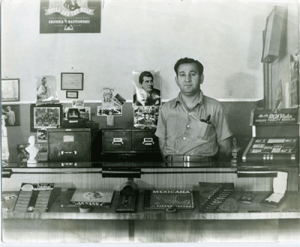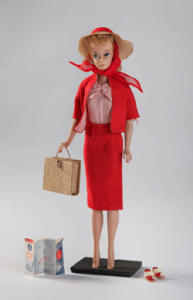Arts
Exhibit
The Arts: A Golden Mosaic

When Los Angeles was incorporated as a city in 1850, there were eight Jews—all bachelors—on the population rolls, and in the ensuing 163 years their number has risen to more than 600,000.
The exhibit “Jews in the Los Angeles Mosaic,” is the most ambitious attempt to encapsulate the history of this vibrant community. It is open through January 5, 2014, at Autry National Center of the American West in Los Angeles.
Visitors to the exhibit are greeted by familiar names, among them the movie industry’s founding fathers Adolph Zucker, Louis B. Mayer and Sam Goldwyn (born Shmuel Gelbfisz), all immigrants from Eastern Europe who created “an empire of their own” —the title of Neal Gabler’s book on how Jewish invented Hollywood—in sunny Hollywood.
Their latter-day descendents include film directors from Billy Wilder to Steven Spielberg and actors ranging from Edward G. Robinson to Barbra Streisand. Not forgotten are the great Dodgers pitcher Sandy Koufax or Ruth Handler, who created the ubiquitous Barbie and Ken dolls.
True to the title, the exhibition focuses on two historical interactions—the impact of the Jewish community on the evolution of Los Angeles, and the way the city and its multiethnic population has changed and molded its Jewish residents, in the process creating a Jewish persona distinct in attitude and lifestyle from its East Coast and Midwestern cousins.
The first of three chronological displays, Remaking Los Angeles/Making Los Angeles (1850-1900), illustrates that Jews were part of Los Angeles—and of much of the American West—from the beginning.
Using maps, models, artifacts, business correspondence and broadsides as emblems of the rich fabric of the region, curator Karen S. Wilson introduces viewers to community and to the Hebrew Benevolent Society, founded in 1854 as the city’s first charitable organization,
Life was hard on the new frontier, so, early on in Los Angeles, people were judged mainly by their labor, not by their religion or ethnic background. In such an environment, “bigotry was a luxury,” Wilson noted.
The next display, titled Growing Pains, spans the first 50 years of the 1900s, which proved to be a setback from the initial era of equality.

With the completion of transcontinental rail links in the late 19th century, white Protestants, mainly from the Midwest, poured into Southern California, bringing with them inbred anti-Semitic attitudes. As a result, social and commercial clubs and institutions, frequently founded by Jews, now excluded them. The most notorious example was the California Club, established in 1888, which had at least 12 Jews among its 125 founding members. In the 1920s, the club barred all Jews (as well as blacks and women) and it was not until 1976 that Harold Brown, then president of the California Institute of Technology and the following year appointed United States secretary of defense, was admitted as the first Jew in the club’s modern era.
In the 1930s, Jews fleeing the Nazi regime became major figures in the city’s intellectual and artistic life, and various artifacts and letters illustrate the attempts of film director Billy Wilder, conductor Otto Klemperer and composer Arnold Schoenberg and their exiled émigré circle to establish themselves in the New World.
Jews also composed much of the popular music of the era, which can be heard at the listening stations in the galleries.
The exhibition’s third and final epoch, Possibility & Prosperity (1950s-2000s), features the contributions of Jewish entrepreneurs and professionals in developing vast suburban housing tracts and new architectural styles, fashions and artistic expressions.
In politics and sports, Jews who once played prominent roles behind the scenes stepped out in front, encapsulating the rise of a new generation of young Jews entering—and succeeding—in fields generally considered non-Jewish domains.
Jews played a major role in helping to elect Tom Bradley become the city’s first black mayor in 1973, backing the civil rights movement and, in later years, fueling the anti-Vietnam war protests.
Among other community actions saluted in the exhibit is the drive by young Jewish activists to help Jews in the former Soviet Union and to establish the first gay and lesbian synagogue, Beth Chayim Chadashim, while local survivors among them Marsha Loen, Felicia Haberfeld and Lidia Budgor, founded the first Holocaust museum in the United States.
Located toward the end of the exhibition is a public square that encourages visitors to share through an interactive question-and-answer display, twitter feed and e-mail messages their own views of the future, in line with the city’s “particularly Western ethos of unfettered reinvention,” as Wilson put it.
Wilson acknowledged that even with 5,000 square feet of floor space, 150 artifacts, 80 photographs, two listening stations featuring more than 50 songs, five videos and two spoken-word audio excerpts, there are gaps in the exhibit’s coverage of Los Angeles Jewish life and history.
For instance, she said, there is little mention of the city’s many eminent rabbis or of prominent Jewish neighborhoods, the rise of the garment industry and the roles of Jews here in law enforcement and politics.
However, Wilson emphasized that the main aim of the exhibit is to look “outwardly” at the interactions of Jews with the rest of Los Angeles, rather than “inwardly” to the makeup of the Jewish community.
An extensive program of talks, symposia, film screenings, musical events and bus tours of Jewish Los Angeles will accompany the exhibit. For additional information, www.TheAutry.org or phone 323-667-2000.










 Facebook
Facebook Instagram
Instagram Twitter
Twitter
Leave a Reply